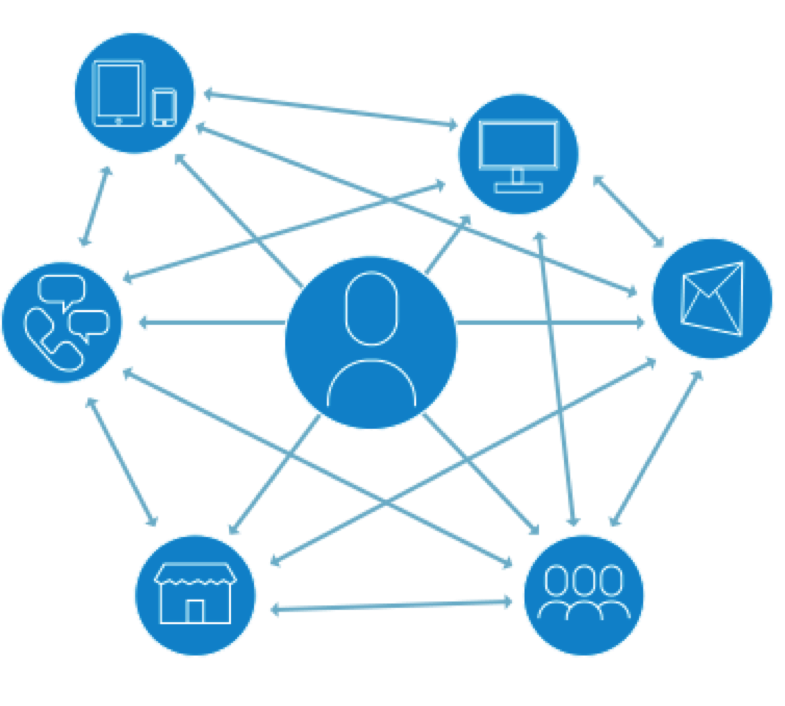Active Listening
Are you “actively” listening to your customers and members?
Today’s world is global, digital and connected. Information, opinions, thoughts, reviews, and comments spread instantaneously and in far reaching ways. Are you listening? Are you actively listening to what is being said about your organization? Do you know what impact all of those words, comments and opinion are having on you in real time? What impact they are having on your revenue? What impact they are having on your organization? Do you know the level of satisfaction your members and customers have with your organization?
I am going to provide you some options that allow you to actively listen, really listen proactively to your customers and reap the benefits of that change in your organization’s behavior. Benefits to include higher levels of satisfaction, greater understanding of your member and customer’s needs, and increased revenue.
Most organizations rely on periodic surveys to gage satisfaction and insight across their members and customers. Most surveys occur on a yearly basis and are used to assess the needs of members and customers and determine their satisfaction with current offerings/products and direction of the organization.
Organizations take action on what they hear, discover and learn via surveys. These actions are reactive. The issues, challenges or needs may have existed for months, a year or longer. In that time you have missed the opportunity to engage with your members, customers and your greater constituency. In that time, how much negative feedback has spread across the digital world? How many friends and “promoters” have you lost in that time? How many “detractors” have you created in that time? I will share more about promoters and detractors later.
If you are conducting more than annual surveys, is what you are asking consistent across all activities? Or are you creating a hodgepodge of data that is hard to understand?
Think about it…humans like to complain and share the negative. We are wired to express our frustrations but we also FORGET and over time remember things differently than what actually occurred. As an example, you find yourself with a flat tire on the way to work and are stuck on the side of a highway. You realize you don’t have a spare and need to call for service. Due to rush hour traffic you wind up waiting 2 hours for the service truck. During your wait and for days after, you are frustrated, perhaps angry and readily share with those around you. Time lost, poor service.
But wait 6 months or even a year to pass and your story may be quite different. You surely remember the flat tire and being stuck on the road but have your memories and perception along with emotion changed? Surely they have. Are you still telling the story of the flat tire? More than likely, other life events and things more important got in the way. The past is the past and you have moved on.
So now you find yourself completing a survey. You provide your answers but those answers are provided with the filters of the here and now, not what happened nor was top of mind six months ago and definitely not reflective of the emotion you felt at the time.
You as the member/customer or you as the organization are missing valuable feedback because of the passage of time.
Here is another example: we humans adjust, we are adaptable. We may get frustrated, we may want different things but again other things in life may get in the way or take our attention away and we adapt. Perhaps you dread making a call to a company because you know you will spend time stuck in the interactive voice recognition system, you prepare yourself and make the call. As you suspected you get frustrated although you complete the needed business and you move on. Did you get the opportunity to tell the company their service is frustrating? Do they know how you dread making that call twice a year? Once a year? Well you probably didn’t get the opportunity to share your feedback and it is a fairly safe guess that they don’t know about the your frustrations or frustrations of other customers.
Yes we are forgetful, yes we apply filters, but opinions get formed. They may be subconscious or top of mind but they exist. You may not express your opinion about the service but something holds you back when a friend asks you about the company. You don’t find yourself readily recommending them.
Lets head back for a few minutes to the digital and global landscape. Have you begun your digital transformation? Can you provide high quality user focused services online?
Lets focus a moment on the member and customer experience particularly in this new digitally engaged wide reaching world:
It might be easiest to think of deconstructing your customer experience from your enterprise goals backwards.
- Every organization wants to grow and have financial success.
- In order to do that, you need to drive your customers to exhibit behaviors that match those financial goals.
You need them to convert, to be loyal and to recommend your brand to others. You need them to become “Promoters”.
On the other side, you need to model how you are managing the experience to drive those behaviors.
Elements of you digital experience need to meet the expectations of your customers.
If the experience meets the customers expectations, customers will be satisfied.
If they are satisfied, they will be more likely to exhibit the behaviors that will drive your financial goals.
(Courtesy of Eric Feinberg, Foresee)
It’s very intuitive. A happy customer buys more and is an advocate for your brand and become “promoters” as a result.
But it is harder to maintain a deep relationship with those who will from now into the future interact with you mostly via digital means.
Demographically, audiences (your members, your customers, and you) are becoming more digitally savy. Soon the generations who adopted technology will be retired and no longer a significant revenue source for you. Those who have grown up with technology and have integrated digital into their daily lives and cant live without it will be your core members and customers. The integrated digitally savy demographic have expectations that every person and organization they interact with or want to interact with can meet them via digital means.
Is this a new challenge? Yes and no.
In the YES bucket: All organizations know that they need to grow and adapt which includes being responsive to the needs and desires of the day. This could be advocacy and issue related, new service related or due to changes in professional practice.
In the NO bucket: Technology is fundamentally changing how we live, interact, communicate and engage. It has also catalyzed a demand and expectation for “instant” gratification and satisfaction. It has catalyzed members and customers to have higher expectations from organizations they interact with.
WHY?
Because there are companies who are adopting and taking advantage of the opportunities created by technology and digital. This has created a huge shift for organizations that once had a single channel of interaction. The single channel for most organizations was comprised of written correspondence and voice contact, voice contact that occurred during traditional business hours, and of course the always-dated annual surveys. Organizations often react to one or several letters that may or may not represent the true majority sentiment. Changes to services, changes in messaging or the like occur because of this very vocal minority that is thought to be representative of the whole.
With the single channel and traditional means of collecting member and customer feedback…organization find themselves looking reactively backwards. In the time that has passed issues and challenges in service delivery or the like continue to impact the members and customers. At this point it could be too late in the game to recover. Organizations may have lost members, seen unexplained decreasing revenue, or a powerful and growing “word of mouth” that has tarnished the organization’s image and brand. This type of situation can be a significant one to recover from.
“Institutional Knowledge”
Of further influence is what can be called institutional knowledge. The knowledge everyone in an organization believes is truly representative of the member and customer. Institutional knowledge creates assumptions and is predetermined by what an employee knows about how the organization works. Institutional knowledge creates perception filters and gaps in really understanding what the challenges, issues or needs are for your members and customers. Actions and reactions come with the filters applied and may not result in really addressing the member or customers frustrations. Now we really have a problem. As I described earlier, you as a human and a customer have filters and now we are adding in more humans with even more filters.
Take a look at this cartoon demonstrating what can be developed with full filters applied…by the time an organization gets to the finish line they may have developed a great product at significant expense that doesn’t resonate with what the members or customers were actually hoping for.
(Credit: Hurst, Mark and Terry, Phil from Customers Included)
How can you avoid these types of situations and be prepared for the current and future dynamic environments and shifts in your member and customer base?
First recognize that you are in or need to be thinking in terms of an Multi-Channel environment. Where interaction points cross the spectrum of the physical and digital world. Where communication is occurring over multiple entry points and types, all hours, all days, all of the time and in many different places.
http://foreseeblog.com/2013/12/12/best-practices-measuring-omnichannel-customer-experience/
The reality is that for at least the next 3-5-10 years members and customer will still be experiencing you via multiple channels. We need to optimize for the last mile of customer experience in each of the channels.
If you aren’t recognizing the Multi-channel and multi channel environments, valuable member and customer insight and input is being left on the digital and physical tables. Real time views into trends and issues that can help you accurately forecast are being missed.
So, I have talked a lot of about a variety of problems and challenges that you face. The problems and challenges are significant and should cause you to think in different ways and terms. What would I recommend you do?
Challenge your organization to consider changing the way you listen…change to tools and approaches that allow you to “actively” listen. We all believe we are good listeners…in a conversation with friends, co-workers and customers…do we listen to every word being said or are we already making assumptions on what will be said next? Oh the FILTERS, here we go again…Are we thinking in real time about questions we are going to ask or comments we are going to make? Do we exercise control of our attention to ensure we are “really” listening? We readily apply filters to all of our conversations and interactions…
Active listening requires you to remove those filters, exercise restraint and control, separating your own thoughts and opinions, and really listen to what is being said, keeping what is said in context of the person speaking. Even if a member or customer is using their own filters, they are your member and customer and are critical to your current and future business.
How?
Tools and approaches like Net Promoter (NPS or Net Promoter Score) can be used across all channels, physical events and services, digital events and services and more. There are additional tools and approaches available including the American Consumer Satisfaction Survey, owned by ForeSee Results that can provide even deeper insight across all interaction points.
Learn more about these tools and approaches from my previous post.
In addition to strategies to interact directly use the insight gained to look holistically across the organization. Are you hearing high quantities of feedback concerning the member/customer experience? Are you hearing about frustration points either digitally or physically? Are you hearing your meetings or products need to improve?
Take what you hear and begin to make tweaks and small changes to the services, experiences or events you are offering. Ensure your thinking stays pro-active. Planning for a large replacement or change is hard and takes time. Time is a luxury that you may not have.
As an example: if you are hearing from many detractors or passives that the online purchase process is difficult, investigate ways to make the process easier. If wait times for phone contact are long, consider adding staff.
You don’t need to be revolutionary. You evolution should, however, involve constant and active listening and continued tweaks and adjustments. Ensure you are measuring the impact of your tweaks and adjustments. Adding to the number of promoters (your satisfied members and customers) will increase your bottom line and ensure positive word of mouth is the norm not the exception.
If you think NPS, ForeSee’s ACSI and Active Listening is where you should be heading to, I can help you with doing so, your effort is best to focus holistically across the organization. A holistic approach will allow you to have and demonstrate the overall performance and satisfaction across the organization while looking consistently and cohesively across areas and offerings and how experiences at the different levels can correlate up to the overall sentiment for the organization. A holistic approach can assist staff who have ownership of the parts make adjustments actively and proactively.
I covered a lot of ground here, I want to share that this is a simple but highly impactful way to engage and improve the organization (and of course to stabilized and grow your revenue).









This Post Has 0 Comments